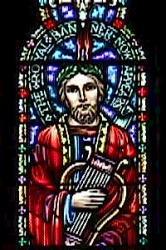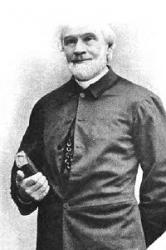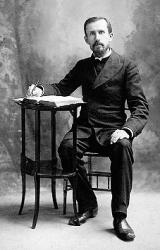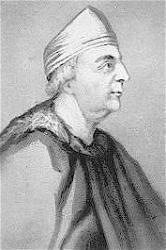Planning worship?
Check out our sister site, ZeteoSearch.org,
for 20+ additional resources related to your search.
- |
User Links
Person Results
Venantius Honorius Clementianus Fortunatus

540 - 600 Person Name: V. Fortunatus Author of "See! through his holy hands and feet" in The Seventh-Day Adventist Hymn and Tune Book Venantius Honorius Clematianus Fortunatus (b. Cenada, near Treviso, Italy, c. 530; d. Poitiers, France, 609) was educated at Ravenna and Milan and was converted to the Christian faith at an early age. Legend has it that while a student at Ravenna he contracted a disease of the eye and became nearly blind. But he was miraculously healed after anointing his eyes with oil from a lamp burning before the altar of St. Martin of Tours. In gratitude Fortunatus made a pilgrimage to that saint's shrine in Tours and spent the rest of his life in Gaul (France), at first traveling and composing love songs. He developed a platonic affection for Queen Rhadegonda, joined her Abbey of St. Croix in Poitiers, and became its bishop in 599. His Hymns far all the Festivals of the Christian Year is lost, but some of his best hymns on his favorite topic, the cross of Jesus, are still respected today, in part because of their erotic mysticism.
Bert Polman
==================
Fortunatus, Venantius Honorius Clementianus, was born at Ceneda, near Treviso, about 530. At an early age he was converted to Christianity at Aquileia. Whilst a student at Ravenna he became almost blind, and recovered his sight, as he believed miraculously, by anointing his eyes with some oil taken from a lamp that burned before the altar of St. Martin of Tours, in a church in that town. His recovery induced him to make a pilgrimage to the shrine of St. Martin, at Tours, in 565, and that pilgrimage resulted in his spending the rest of his life in Gaul. At Poitiers he formed a romantic, though purely platonic, attachment for Queen Rhadegunda, the daughter of Bertharius, king of the Thuringians, and the wife, though separated from him, of Lothair I., or Clotaire, king of Neustria. The reader is referred for further particulars of this part of the life of Fortunatus to Smith and Wace's Dictionary of Christian Biography, vol. ii. p. 552. It is sufficient to say here that under the influence of Rhadegunda, who at that time lived at Poitiers, where she had founded the convent of St. Croix, Fortunatus was ordained, and ultimately, after the death of Rhadegunda in 597, became bishop of Poitiers shortly before his own death in 609.
The writings, chiefly poetical, of Fortunatus, which are still extant, are very numerous and various in kind; including the liveliest Vers de Societé and the grandest hymns; while much that he is known to have written, including a volume of Hymns for all the Festivals of the Christian Year, is lost. Of what remains may be mentioned, The Life of St. Martin of Tours, his Patron Saint, in four books, containing 2245 hexameter lines. A complete list of his works will be found in the article mentioned above.
His contributions to hymnology must have been very considerable, as the name of his lost volume implies, but what remains to us of that character, as being certainly his work, does not comprise at most more than nine or ten compositions, and of some of these even his authorship is more than doubtful. His best known hymn is the famous "Vexilla Regis prodeunt," so familiar to us in our Church Hymnals in some English form or other, especially, perhaps, in Dr. Neale's translation, "The Royal Banners forward go." The next most important composition claimed for him is "Pange, lingua, gloriosi praelium certaminis," but there would seem to be little doubt according to Sirmond (Notis ad Epist. Sidon. Apollin. Lib. iii., Ep. 4), that it was more probably written by Claudianus Mamertus. Besides these, which are on the Passion, there are four hymns by Fortunatus for Christmas, one of which is given by Daniel, "Agnoscat omne saeculum," one for Lent, and one for Easter. Of "Lustra sex qui jam peregit," of which an imitation in English by Bishop. Mant, "See the destined day arise," is well-known, the authorship is by some attributed to Fortunatus, and by some to St. Ambrose.
The general character of the poetry of Venantius Fortunatus is by no means high, being distinguished neither for its classical, nor, with very rare exceptions, for its moral correctness. He represents the "last expiring effort of the Latin muse in Gaul," to retain something of the "old classical culture amid the advancing tide of barbarism." Whether we look at his style, or even his grammar and quantities, we find but too much that is open to criticism, whilst he often offends against good taste in the sentiments he enunciates. Occasionally, as we see in the "Vexilla Regis," he rises to a rugged grandeur in which he has few rivals, and some of his poems are by no means devoid of simplicity and pathos. But these are the exceptions and not the rule in his writings, and we know not how far he may have owed even these to the womanly instincts and gentler, purer influence of Rhadegunda. Thierry, in his Récits des Temps Mérovingiens, Récit 5, gives a lively sketch of Fortunatus, as in Archbishop Trench's words (Sacred Latin Poetry, 1874,p. 132), "A clever, frivolous, self-indulgent and vain character," an exaggerated character, probably, because one can hardly identify the author of "Vexilla Regis," in such a mere man of the world, or look at the writer of "Crux benedicta nitet, Dominus qua carne pependit" q.v., as being wholly devoid of the highest aspirations after things divine. A quarto edition of his Works was published in Rome in 1786. [Rev. Digby S. Wrangham, M.A.]
- John Julian, Dictionary of Hymnology (1907)
====================
Fortunatus, V. H. C., p. 384, i. The best edition of his poems is F. Leo's edition of his Opera Poetica, Berlin, 1881 (Monumenta Germaniae, vol. iv.).
--John Julian, Dictionary of Hymnology, Appendix, Part II (1907)
Venantius Honorius Clementianus Fortunatus
Francis Bottome

1823 - 1894 Person Name: Rev. F. Bottome Author of "Search Me, O God!" in Hymns of Consecration and Faith Bottome, F., S.T.D., was born in Derbyshire, England, May 26, 1823. In 1850, having removed to America, he entered the ministry of the Methodist Episcopalian Church; and in 1872 he received the degree of S.T.D. from Dickinson's College, Carlisle, Penn. In addition to assisting in the compilation of B. P. Smith's Gospel Hymns, London, 1872: Centenary Singer, 1869; Hound Lake, 1872, he has written:—
1. Come, Holy Ghost, all sacred fire. Invocation of the Holy Spirit. Appeared in R. P. Smith's Gospel Hymns, 1872. It is in several collections, including the Ohio Hymn Book of the Evangelical Association, 1881, No. 364.
2. Full salvation, full salvation. Joy of full Salvation. Written in 1871, and published in a collection by Dr. Cullis of Boston, 1873. Also in the Ohio Hymn Book, 1881, No. 384.
3. Love of Jesus, all divine. Love of Jesus. Written in 1872, and published in his Hound Lake, 1872. It is in several collections.
4. O bliss of the purified, bliss of the free. Sanctification. Written in 1869, and published in the Revivalist, and numerous hymn-books in America, including the Ohio Hymn Book as above, 1881, No. 477, &c.
His hymns, "Sweet rest in Jesus"; and "Oneness in Jesus," are also found in several collections for evangelistic services.
-- John Julian, Dictionary of Hymnology (1907)
Francis Bottome
Edward Payson Hammond

1831 - 1910 Person Name: Edward Hammond Author of "Gethsemane" in The Cyber Hymnal Hammond, Edward Payson, was born at Ellington, Connecticut, Sep. 1, 1831. He edited Hymns of Prayer and Praise, and is the author of a few pieces in that and other evangelistic hymnals, including "Christian [Children] go and tell Jesus," and "I feel like singing all the time."
--John Julian, Dictionary of Hymnology, Appendix, Part II (1907)
================
Born: September 1, 1831, Ellington, Connecticut.
Died: August 14, 1910.
Payson was converted when he heard Alas, and Did My Savior Bleed. He was educated at various American schools, and finished his theological education in Edinburgh, Scotland. In Scotland, he started to preach in places with no Christian activity, and he could see fruit of his work. At the end of 1861 he returned to America and preached in Chicago, Illinois, where he met Dwight Moody. In 1866 he and his wife traveled to Egypt, Palestine and Europe. While in Palestine, he wrote the hymn Gethsemane. He was very fond of preaching to the children, and was called "The Children’s Evangelist." His works include:
Hymns of Prayer and Praise (editor)
Jesus the Children’s Friend, 1864
New Praises of Jesus, 1869
The Armor Bearer: a Choice Collection of New and Popular Hymns and Music, with Warren Bentley (New York: William A. Pond, circa 1876)
--hymntime.com/tch
Edward Payson Hammond
Guillaume Franc
1500 - 1570 Person Name: G. Franc Composer of "[Forever here my rest shall be]" in Songs of Victory
Guillaume Franc
Martin W. Knapp

1853 - 1901 Person Name: M. W. Knapp Author of "Forgiveness" in Tears and Triumphs Born: March 27, 1853, Albion, Michigan.
Died: December 7, 1901, Cincinnati, Ohio, of typhoid fever.
Buried: Spring Grove Cemetery, Cincinnati, Ohio.
At age 17, Knapp began studies at a Methodist college in Albion, Michigan. He worked on the family farm in the summer, studying Greek and Latin at night, and attending classes in Albion in the winter. In 1877, the Methodist Michigan Conference assigned him a circuit. He went on to a career in ministry, founding the magazine God’s Revivalist in 1888; the International Holiness Union and Prayer League in 1897; and God’s Bible School (later known as God’s Bible School and College) in Cincinnati, Ohio, in 1900. His works include:
Christ Crowned Within, 1886
The Double Cure
Out of Egypt into Canaan, or Lessons in Spiritual Geography
Diary Letters; A Missionary Trip Through the West Indies and to South America
The River of Death and Its Branches
Pentecostal Preachers
Revival Kindlings, 1890
Revival Tornadoes; or, Life and Labors of Rev. Joseph H. Weber (McDonald, Gill & Company, 1890)
Impressions—How to Tell Whether They Are from Above or Below (Revivalist Publishing House; sixth edition, 1892)
Lightning Bolts from Pentecostal Skies; or, Devices of the Devil Unmasked, 1898
Holiness Triumphant, or, Pearls from Patmos, 1900
Bible Songs of Salvation and Victory, with R. E. McNeill (Cincinnati, Ohio: M. W. Knapp, circa 1902)
--www.hymntime.com/tch/
Martin W. Knapp
John Samuel Coffman
Person Name: John S. Coffman Author of "O Weary Wanderer" in Church Hymnal, Mennonite
John Samuel Coffman
Anonymous
Person Name: Anon. Author of "There is a dear and hallowed spot" in The Seventh-Day Adventist Hymn and Tune Book In some hymnals, the editors noted that a hymn's author is unknown to them, and so this artificial "person" entry is used to reflect that fact. Obviously, the hymns attributed to "Author Unknown" "Unknown" or "Anonymous" could have been written by many people over a span of many centuries.
Anonymous
Samuel Wesley

1662 - 1735 Author of "Behold the Saviour of mankind" in The Seventh-Day Adventist Hymn and Tune Book Father of Samuel Wesley, John Wesley, and Charles Wesley.
See also in: Hymn Writers of the Church
======================================================================================================
Samuel Wesley, M.A., the elder, was born in 1662 at Whitchurch in Dorsetshire, of which parish his father, John Wesley, was Vicar until the Act of Uniformity caused him to resign his living. He was educated at a Dissenting academy by a Mr. Morton, and was designed for the Nonconformist Ministry. But having been, on account of his talents, selected as a champion to defend the dissenters against some severe invectives, and having commenced a course of controversial reading for this purpose, he was led by his studies to embrace the opposite views, and became, and continued through life, a pronounced churchman. With the impetuosity which was a family trait, he set forth on foot to Oxford, and entered himself at Exeter College. In spite of his straitened means, he managed to keep his terms and take his degrees at the University.
He then received Holy Orders and took a curacy of £28 a year. Having held this curacy for a year, he obtained a naval chaplaincy, and then took another curacy in London. About the year 1690 he married Susanna, daughter of Dr. Annesley, a famous Nonconformist minister, and a scion of the noble house of Anglesey. The wife, like the husband, had been brought up as a dissenter, but at the early age of 13 she had come over to the Church of England, and was afterwards a Jacobite in politics. In 1693 Mr. Wesley was presented to the living of South Ormsby in Lincolnshire. He was also chaplain to the Marquis of Normandy, afterwards Duke of Buckingham. In 1697 he was appointed by the Crown to the Rectory of Epworth, and there he spent the remainder of his life, nearly forty years. The first part of his residence at Epworth was marked by a series of troubles arising partly from his pecuniary embarrassments, which increased with his increasing family, partly from the animosity of his parishioners, who resented the part which he felt it his duty to take, as a staunch churchman, in politics, and partly from unfortunate accidents. These troubles reached their climax in 1705, when he was thrown into Lincoln gaol for debt. They are graphically described by his own pen.
"I have been thrown behind," he writes to his good friends at Oxford, "by a series of misfortunes. My Parsonage Barn was blown down ere I had recovered the Taking my Living; My House great part of it burnt down about 2 years since. My Flax, great part of my Income now in my own Hands, I doubt wilfully fir'd and burnt in ye night, whilst I was last in London. My Income sunk about one half by the low price of Grain and my credit lost by the taking away my Regiment. I was brought to Lincoln Castle June 23rd last past. About 3 weeks since my very unkind People, thinking they had not yet done enough, have in ye night stabbed my 3 cows, wch were a great part of my poor Numerous Family's Subsistence.—For wch God forgive them."
Some points in this letter require explanation. When he speaks of being in London, he means on Convocation business; for he was elected Proctor for the Diocese, and in one of his absences Mrs. Wesley instituted those religious meetings at the Rectory which are thought by some to have been the precursors of the Wesleyan Society Meetings. “His Regiment" was a Chaplaincy in the army which had been given him in reward for a poem in praise of the Duke of Marlborough. The last and worst of the many fires through which he suffered was in 1709, when the rectory was entirely burnt down, and the present house erected in its place. The latter part of his time at Epworth was more free from troubles. He met with many generous friends who enabled him to emerge from his pecuniary difficulties, the firmest and most constant of these friends being the admirable Archbishop of York, Dr. John Sharp; his sons grew up to be a comfort and a credit to him; his income was slightly increased by the addition of the neighbouring living of Wroot; and his parishioners gradually became more tractable. The annoyance caused by the famous Epworth Ghost can scarcely be reckoned among his serious troubles. In 1731 he met with an accident which probably hastened his end, and in 1735 he passed away and was buried in Epworth churchyard, leaving behind him the character of an excellent parish priest, a good husband and father, and a man of very considerable abilities and attainments.
Mr. Wesley was a somewhat voluminous writer. His first publication was a volume of poems bearing the unpromising, not to say repulsive, title of Maggots. It appeared in 1685. In 1691 he became the clerical correspondent to the Athenian Gazette (afterwards Mercury) published by his brother-in-law, John Dunton. In 1693 appeared an Heroic Poem on the Life of Our Blessed Lord and Saviour Jesus Christ. This was dedicated to Queen Mary, and led to his appointment to the living of Epworth. In 1695 he published Elegies on Queen Mary and Archbishop Tillotson; and in 1698 A Sermon preached before the Society for the Reformation of Manners. The Elegies are rather fulsome and in bad taste according to the standard of the present day; but it should be remembered that high-flown panegyrics were the fashion of the age. The Sermon is a spirited and energetic defence of the "Societies," which were regarded with some suspicion by many high-churchmen, but of which Mr. Wesley, like his friend Robert Nelson, was a warm supporter. In 1700 he published The Pious Communicant rightly prepared; or a Discourse concerning the Blessed Sacrament, &c, With Prayers and Hymns suited to the several parts of that holy office. To which is added A short Discourse of Baptism. In this work appeared his version of the "Great Hallel" or "Paschal Hymn." In 1704 he published The History of the Old and New Testaments in Verse, in three volumes, which he dedicated to Queen Anne. This, like his Life of Christ, was illustrated with numerous and costly engravings. In 1705 he published a poem of nearly 600 lines on the "Battle of Blenheim," entitled Maryborough, or The Fate of Europe. For this he was rewarded with the Chaplaincy of Colonel Lepell's regiment; but his political enemies at Epworth soon succeeded in getting him deprived of this office. In 1707 appeared A Reply to Mr. Palmer's Vindication of the Learning, Loyalty, Morals, and most Christian Behaviour of the Dissenters towards the Church of England. This originated in the publication, without his consent or knowledge, of a Letter he wrote to a friend Concerning the Education of the Dissenters in their Private Academies. The letter was attacked anonymously and defended by Mr. Wesley in a pamphlet (1704). The pamphlet was answered by Mr. Palmer. After this, Mr. Wesley's pen seems to have rested for some time; but during the last ten years of his life he was engaged in his elaborate Dissertation on the Book of Job, his incessant labours upon which are said to have hastened his end. This work was dedicated to Queen Caroline, the wife of George II., and presented to her by John Wesley some months after the author's death.
Perhaps if he had written less, and spent more time in elaborating what he did write, he might have been more successful; but, after all, the "Divine afflatus" must have been wanting; and the best service which he rendered to sacred poetry was in being father of his children.
Two of his hymns are in common use:—
1. Behold the Saviour of mankind.
2. 0 Thou Who, when I did complain.
-- Excerpts from John Julian, Dictionary of Hymnology (1907)
Samuel Wesley
Herbert B. Turner
1852 - 1927 Person Name: H. B. T. Arranger of "THE VOLUNTEERS" in Hymns and Tunes for Schools Turner, Herbert Barclay; b. 1852, Brooklyn, New York, d. 1927, Washington, Connecticut; composer
Herbert B. Turner


 My Starred Hymns
My Starred Hymns

